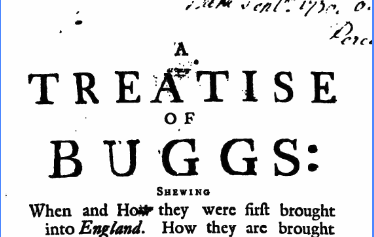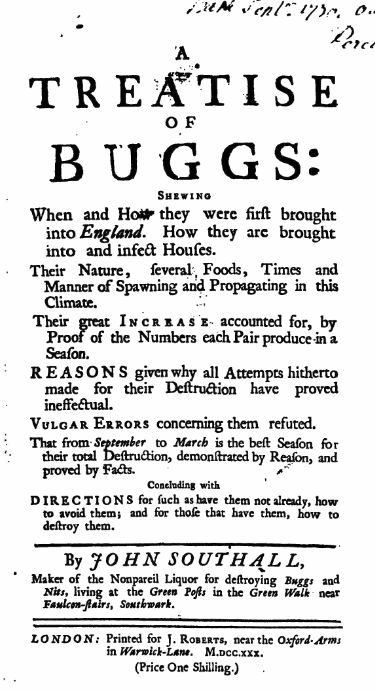TLDR; A treatise on non-software bugs, written in 1730, but still with lessons to learn.

Written in 1730 by John Southall
Bug Prevention and Detection has been a problem throughout the ages.
I found a reference to A Treatise in Buggs when reading through “A History of Advertising” on Project Gutenberg.
- you can read A Treatise in Buggs online at archive.org
The quote in A History of Advertising contains an advert that the wife of Author John Southall placed in the London Daily Post and General Advertiser on March 15, 1740
The Advert
MARY SOUTHALL
Successor to John Southall, the first and only person that ever found out the nature of Buggs, Author of the Treatise of those nauseous venomous Insects, published with the Approbation (and for which he had the honour to receive the unanimous Thanks) of the Royal Society,
Gives Notice,
THAT since his decease she hath followed the same business, and lives at the house of Mrs Mary Roundhall, in Bearlane, Christ Church Parish, Southwark. Such quality and gentry as are troubled with buggs, and are desirous to be kept free from those vermin, may know, on sending their commands to her lodgings aforesaid, when she will agree with them on easy terms, and at the first sight will justly tell them which of their beds are infested, &c., and which are free, and what is the expense of clearing the infested ones, never putting any one to more expense than necessary. Persons who cannot afford to pay her price, and is willing to destroy them themselves, may by sending notice to her place of abode aforesaid, be furnish’d with the Non Pareil Liquor, &c. &c.
I quite like this advert it basically has:
- qualifications, authority through a reference to a book
- a subtle reference to the book without making it the point of the advert
- tells people what service she offers
- has two price points - one for consultancy, and one for a product sale of the ‘Non Pariel Liquor’
The Book - A Treatise of Buggs
The book promises to explain:
“When and How they were first brought into England. How they are brought into and infect Houses”
When did bugs start appearing? How did they appear? And how do they continue to appear?
“Their Nature, several Foods, Times and Manner of Spawning and Propagating in this Climate.”
What is a bug? What leads to bugs given the processes in place?
“Their great Increase accounted for, by Proof of the Numbers each Pair produce -in a Season.”
Statistics and metrics drawn from industry that the problem of bugs is not necessarily getting better.
“REASONS given why all Attempts hitherto made for their Destruction have proved ineffectual.”
Why do we still find it so hard to prevent bugs?
“Vulgar Errors concerning them refuted”
Various claims around efficacy of tools and processes to kill of bugs are shot down with ruthless efficiency.
“DIRECTIONS for such as have them not already, how to avoid them; and for those that have them, how to destroy them.”
But fear not. If you have bugs, then this book will show you how to find them and fix them. And if you have none, then it will show you how to improve your process without subjecting yourself to the risk of new bugs.
Bold claims - worthy of any modern textbook on Software Testing

Lessons Learned
“I have … made their de- struction my Profession, and was at first much baffled in my Attempts for want”
Commit to Software Development as a profession and learn as much as you can. At first, it will be hard and you might well be ‘baffled’ in your attempts. Do not let that put you off.
“I determined by all means possible to try if I could discover and find out as much of their Nature, Feeding and Breeding, as might be conducive to my being better able to destroy them.”
Learn as much about the causes and detection of bugs such that your skills improve and you are ‘better able to destroy them’.
“And tho’ in attempting it I must own I had a View at private Gain, as well as the public Good ; yet I hope my Design will appear laudable, and the Event answer both Ends.”
Share what you learn as this will improve your career prospects, and will help others that follow the same path as you.
“In treating on these Insects, some part of the Discourse may perhaps at first View appear surprising, if not incredible to the Readers : But by giving them an account how I attained my Knowledge, and by often reiterated Experiments proved them to be certain Facts, they will soon alter their Opinion”
You will need to try different approaches. Some of which may surprise you. But, you will learn from the experience and when you communicate your work to others because you are speaking from experience you will more strongly state your case and people will be more likely to try for themselves your methods and achieve similar results. At the very least you are helping people recognise the possibilities inherent in your approaches and that the same ends are within reach to them, if only they can take up your proffered mantle_(try what you tried)_.
What follows then in the book is a tale of gaining a secret recipe for bug prevention from an old freed slave. Recognising that the author could make much money on returning to England if he only knew the secret, he met frequently with the free man (who is never given a name in the book). But John Southall learned how the man “attain’d the great Knowledge I found he had in the medicinal Virtues of Roots, Plants”. And for the price of “some tobacco and a Bit” and “some Egnlish Beef, Pork, Biscuit and Beer, and some Tobacco”; John managed to procure the secret, something that he “so much wanted and desired”.
John posits that after the Great Fire of London, the imported timber that was used to re-build had beasties in them for it was Fir Timber “instead of the good OAck destroyed in the old.”
While John had the ‘secret’ he did not yet know much more, and “Finding no satisfactory Account of their Nature, Breeding, and Feeding, come at from others, I was resolved assiduously to set about and try all possible ways to attain it myself”.
John then provides a detailed account of his studies of bugs, with detailed bug reporting of their development over time.
- Buggs of one day old, are white as Milk.
- At three days old, are Cream coloured
- At one Week old, are Straw coloured
- At two Weeks, are of the fame Colour, with a red Lift down the Back.
- At three Weeks, Lift Copper Colour.
- At four Weeks, Lift Browner.
- At five Weeks, Lift deeper Brown.
- At six Weeks, the Sides brown, and the Lift hardly discernible.
- At seven Weeks, they come to be of their proper Colour, all over brown.
- At eight Weeks, they grow bigger.
- Nine Weeks, Ditto.
- Ten Weeks, Ditto.
- At eleven Weeks, they are full grown.
Clearly, John decided that the ability to observe the bugs and identify them was important, so he conducted a long term soak test to document their development over time.
John warns us that bugs can be most cunning and hard to find, although when found they can be fierce.
“Wild Buggs are watchful and cunning, and tho’ timorous of us, yet in fight one with another, are very fierce”
John refutes the belief that bugs lie dormant in winter.
“The first is, That many People imagine they are dead in Winter. This is a Notion so absurd, that it would hardly be worth mentioning, had I not by Experience found it had prevail’d with many People of Sense and Learning, as well as the Vulgar and Illiterate.”
This belief may have carried through into current development practices by extensive holidays over the Christmas season and code freezes starting in November to accommodate Black Friday and Christmas shopping.
“The Second and most prevailing Error is, That Buggs bite some Persons, and not others : When in Reality they bite every Human Body that comes in their way”
John reminds us that no system or approach to developing systems has a natural immunity to bugs. They bite us all in some way, so we need to take due care and protection.
John then lists the many steps one can take to prevent bug infestations, these are primarily examinations and checks prior to introducing something new into the environment.
“examine well all things from on board Ships before you admit them into Lodging-Rooms”
A warning to be wary of things brought, by staff, from other environments into yours. Be sure that these imports are of acceptable quality and do not just blindly accept them in.
“If you have occassion to change Servants, let their Boxes, Trunks, etc. be well examin’d before carried into your Rooms, left their coming from infected Houses should prove dangerous to yours.”
And so on - examine where you deploy your goods in case the environment contaminates them.
“If you put out your Linen to wash, let no Washer-woman’s Basket be brought into your Houses ; for they often prove as dangerous to those that have no Buggs”
Be wary of all external interaction in “Bugg-Affairs” because after you have everything setup you might have to “have taken it down, because it was buggy, to be brought”.
External suppliers work needs to be checked, as they may try to re-use and re-configure work that is not suitable for you.
“Builders are more blameable than they : for in Houses built for Sale, old Wainscot-Doors, Chimney-Pieces, etc. are oft put up for Cheapness, painted over, and pass for new”
John then provides help for those that would find and destroy bugs, rather than simply prevent their introduction.
“To such as have, and would destroy them, I shall now proceed give full Directions. In order to do it effectually, and to lessen your trouble, the first necessary thing to be known, is their Marks.”
Observing the environment for unexpected marks, cracks, visible movement.
Some you may have to do something to attract them. By introducing something new into the environment forcing them to take action.
“In Winter-time, though they lie in pretty close Quarters, yet are they easily destroy’d with any thing that will attract or entice them to it.”
In 1730 bugs were clearly easier to deal with and upon detection, using the appropriate “Liquor” they would “immediately die before your Face”.
John reminds us that because of the skills involved in detection, the time it takes and hard work that it is often worth calling in an expert in these “Bugg-Affairs”:
“If the Trouble of doing it your selves be disagreeable to you, you may have it expeditiously done by me or my Servants”
Sadly, but not unexpectedly because this was written in 1730, neither John or Mary Southall (nor their servants) are with us, but professionals in “Bugg-Affairs” do still exist.
At only 40 pages this is a splendid little infomercial.
This may add value to yourself, or those servants in your employ.







